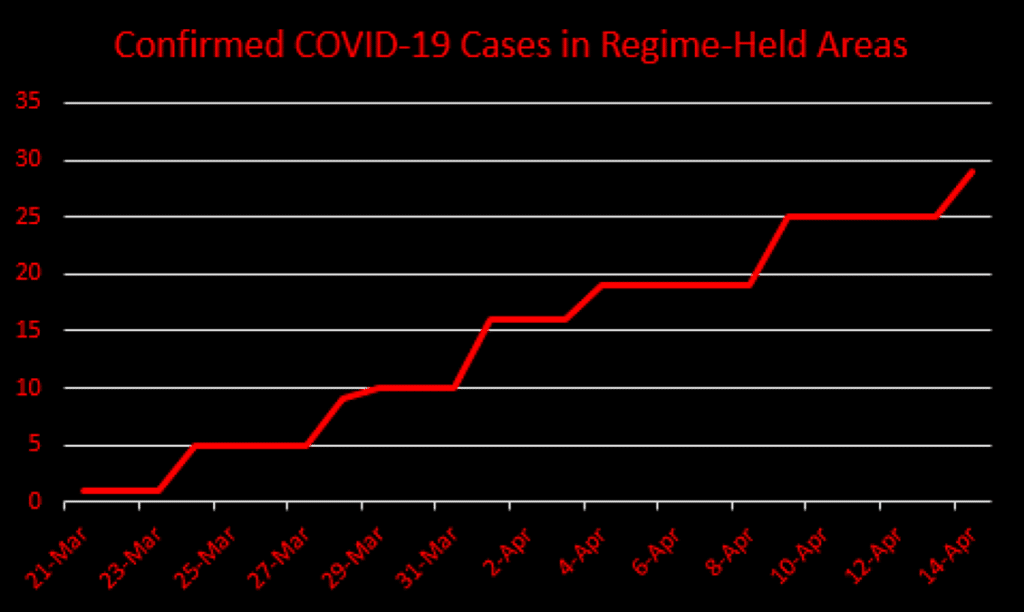April 14, 2020 | Policy Brief
COVID-19 in Regime-Held Syria
April 14, 2020 | Policy Brief
COVID-19 in Regime-Held Syria
The regime of Bashar al-Assad continues to report implausibly low numbers of COVID-19 cases, while evidence mounts of deliberate deception. The presence of tens of thousands of Iranian-backed militia fighters may have introduced, and likely accelerated, the spread of the virus.
Situation Overview
The regime acknowledged its first case of COVID-19 on March 22, after it spent weeks denying reports of other infections. On March 10, a UK-based human rights group reported, citing discussions with doctors inside Syria, that the virus had already spread to four provinces over which the regime exercises effective control, including Damascus. Physicians at the Tishreen Military Hospital told journalists that they had treated foreign militia fighters for what appeared to be COVID-19.
In addition, Pakistani authorities reported six cases of coronavirus involving citizens who had just returned from Syria. The Zeynabiyoun Brigade, one of the Iranian-backed militias fighting on Assad’s behalf, consists mainly of Pakistani fighters. The U.S. Treasury Department sanctioned the Zeynabiyoun last year for terrorism and human rights violations.
Prior to acknowledging its first coronavirus case, the Syrian regime closed the nation’s schools and suspended most foreign travel. In the final week of March, Damascus imposed a nation-wide 6pm-to-6am curfew and banned inter-city travel. Also that week, 11 Iraqi Shiite pilgrims tested positive after returning from Syria. Gradually, the regime has raised the official number of reported cases, which reached 29 on April 14, including two deaths. Meanwhile, independent journalists aggregated reports of 46 cases, 35 of which were in Deir Ezzor, a province with a high concentration of Iranian militia fighters.
To control the flow of information about the pandemic, Syrian intelligence has embedded its personnel in the country’s hospitals, according to an expatriate researcher from Homs. Syria-based physicians also told him they have observed a drastic increase in pneumonia-related deaths, many of which likely were undiagnosed coronavirus cases. Given its lack of capacity to test for COVID-19 – there is a single lab in Damascus that can analyze samples – the regime itself may have little idea of just how far the virus has spread.
COVID-19 in the Greater Middle East
| Country | Cases | Deaths |
| Iran | 74,877 | 4,683 |
| Turkey | 65,111 | 1,403 |
| Israel | 12,046 | 123 |
| Pakistan | 5,837 | 96 |
| Saudi Arabia | 5,369 | 73 |
| UAE | 4,521 | 25 |
| Qatar | 3,428 | 7 |
| Egypt | 2,350 | 178 |
| Algeria | 2,070 | 326 |
| Morocco | 1,888 | 126 |
| Bahrain | 1,522 | 7 |
| Iraq | 1,400 | 78 |
| Kuwait | 1,355 | 3 |
| Oman | 813 | 4 |
| Tunisia | 726 | 34 |
| Afghanistan | 714 | 23 |
| Lebanon | 641 | 21 |
| Jordan | 397 | 7 |
| W. Bank & Gaza | 308 | 2 |
| Somalia | 60 | 2 |
| Sudan | 32 | 5 |
| Syria | 29 | 2 |
| Libya | 26 | 1 |
| Yemen | 1 | 0 |
Source: JHU Coronavirus Resource Center
Data current as of 3:30 PM, April 14, 2020.
Implications
The Assad regime owes its survival largely to military and financial assistance from Iran. An admission that Iranian-backed fighters brought and spread the virus would be a major embarrassment to both the Assad regime and Tehran.
In the first week of April, the regime belatedly restricted movement in and out of the Sayyida Zeinab neighborhood southeast of Damascus, where Iranian-backed militias maintain their headquarters. Authorities also sealed the Sayyida Zeinab shrine, which gives the neighborhood its name and draws tens of thousands of Iranian pilgrims each year.
Western diplomats told Reuters that the Iranian carrier Mahan Air continued regular flights from Tehran to Damascus even after the suspension of other arrivals. Treasury first sanctioned Mahan Air in 2011 for supporting terrorism; the department has also concluded that Mahan “contributed to mass atrocities” in Syria through its years of support for the Assad regime.
What to Watch for
The precursors of a major outbreak are clearly visible in Syria, yet the regime’s control of the healthcare system ensures that thousands of cases may remain hidden from the outside world. The UN’s top aid official warned that the handful of cases Damascus acknowledges represent only the “tip of the iceberg.”
The regime may be able to maintain the pretense of a minor outbreak until the pandemic overwhelms the country’s dilapidated hospitals. A study by the London School of Economics found that Syria’s healthcare system has only 325 beds with ventilators in intensive-care units, although just over 40 are in areas outside regime control. Based on the assumption that 5 percent of coronavirus patients require ventilators, the study estimated that the system could handle at most 6,500 cases.
While a catastrophe may be imminent, it is also possible that the epidemic will claim only several thousand lives, a number small enough to blend in with the overall devastation that Assad and his allies have inflicted on Syria.
David Adesnik is research director and a senior fellow at the Foundation for Defense of Democracies (FDD), where he contributes to FDD’s Center on Military and Political Power (CMPP). For more analysis from David and CMPP, please subscribe HERE. Follow David on Twitter @adesnik. Follow FDD on Twitter @FDD and @FDD_CMPP. FDD is a Washington, DC-based, nonpartisan research institute focusing on national security and foreign policy.
